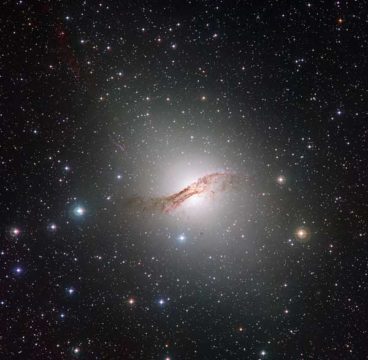Most of the dwarf galaxies around Centaurus A appear to be orbiting the giant galaxy along a single plane — a result not predicted by current cosmological models.
It’s a bit like walking into your teenage daughter’s room and encountering a tidy place instead of an exploded wardrobe: Astronomers have found order where they expected chaos, and the new result may challenge cherished cosmological theories.
In this week’s issue of Science, Oliver Müller (University of Basel, Switzerland) and colleagues report on the discovery of surprisingly organized motion among the satellite galaxies that swarm around Centaurus A (NGC 5128), a huge elliptical galaxy some 12 million light-years away.

Current cosmological wisdom — the famous ΛCDM model that describes our universe as consisting mostly of dark energy and cold dark matter — predicts that large galaxies should be surrounded by a chaotic swarm of tiny dwarfs. Instead, out of the 16 Cen A satellites with known radial velocities, 14 move in an orderly pattern. They orbit on a broad plane that’s more or less perpendicular to the large galaxy’s famous dust band, all 14 moving in the same circular direction.
A more or less similar result was found five years ago for our own Milky Way galaxy and for the Andromeda galaxy (M31). Back then, some theorists argued that gravitational interactions within our Local Group of galaxies might be responsible for this unexpected order. That explanation doesn’t work for Centaurus A, though.
The likelihood of finding just one example of coordinated motion of dwarf satellites in ΛCDM simulations is smaller than 0.5%, according to Müller and his co-authors. “Finding three such systems in the nearby universe seems extremely unlikely,” they write in Science.
The majority of dwarf galaxies around Centaurus A appear to be arranged on a disc-shaped plane. University of Basel/Oliver Müller
“It’s an interesting result,” says Eline Tolstoy (University of Groningen, The Netherlands), an expert on dwarf galaxy evolution. “But it’s still small number statistics. Velocity measurements are only available for the very brightest satellites of Centaurus A — there may be an unknown bias there.”
“But still,” she adds, “it’s very intriguing.”
Her colleague Amina Helmi (also at University of Groningen), who studies the assembly process of galaxies like our Milky Way, is more critical.
“We know that Centaurus A experienced a major merger event in the past,” she says, “but the authors don’t take that into account. Furthermore, they show that planetary nebulae in Cen A show a similar pattern. I believe this result may tell us more about galaxy mergers” than cosmology.
More data on other galaxies and their satellite systems may settle the issue once and for all. However, Tolstoy says, “those are not simple measurements. Our possibilities are limited.” Moreover, Helmi adds, you also need proper motion data on the satellite galaxies to get a complete, three-dimensional picture.
That's exactly what new measurements by the European Space Agency's Gaia mission, to be released in late April, will reveal, at least for all the dwarf galaxies orbiting the Milky Way. "There is a paper by the Gaia Collaboration on science verification and data validation being prepared on this topic," says Helmi, "but right now, I can't reveal any details yet."
 0
0









Comments
You must be logged in to post a comment.